Health Management
Basic Approach
The ANA Group proclaimed the ANA Group Health Management Declaration in April 2016 based on the belief that ensuring employees' health, safety and a comfortable work environment are the foundation of a company's activities.
The Declaration focuses on strengthening employee health management, disease prevention, mental health, and health and safety activities, as well as establishing indicators related to lifestyle-related diseases to monitor progress.
- ANA Group Health Management Declaration (including ANA Group Occupational Safety and Health Policy) has been approved by the Board of Directors.
ANA Group Health Management Declaration

The ANA Group places the highest importance that each employee has a healthy mind and body, and can engage in his or her work with energy and passion. The ANA Group companies, employees and health insurance association work as one to proactively improve both employees' quality of life (QOL) and corporate value, by creating an environment that supports long and healthy careers. This concept reflects the ANA Group Occupational Safety and Health Policy, established on the belief that employees' health, safety and a comfortable work environment are the foundation of a company's activities.
- *1.QOL:stands for Quality of Life, and refers to the quality of life based on health.
The ANA Group aspires to become the world's leading airline group, by taking steps to achieve a brighter future as a corporate group that can grow sustainably together with society.
ANA Group Occupational Safety and Health Policy
- The ANA Group will promote the prevention of accidents on the job, as well as maintain and improve the mental and physical health of employees.
- We will maintain safety and improve health by implementing various measures and management systems (PDCA cycle).
- We will respect laws and regulations, and raise employee awareness through occupational safety and health education.
Shinya Katanozaka
President & CEO, ANA Holdings Inc. (at the time the policy was established)
ANA Group Occupational Safety and Health Policy
In accordance with the "ANA Group Occupational Safety and Health Policy," the ANA Group will make concerted efforts to ensure occupational safety and health for all ANA Group employees, as well as for contractors and subcontractors with whom we work.
- The ANA Group will promote the prevention of accidents on the job, as well as maintain and improve the mental and physical health of employees.
We will establish an effective occupational safety and health management system to achieve the ultimate goal of "zero occupational accidents" for the ANA Group and to maintain and promote the mental and physical health of our employees. - We will maintain safety and improve health by implementing various measures and management systems (PDCA cycle).
Led by the Safety and Health Committee*, we will identify workplace risks through risk assessments and other means, set quantitative targets after determining the level of urgency and priority, and continuously implement the PDCA cycle of the occupational safety and health management system to achieve the targets. - We will respect laws and regulations, and raise employee awareness through occupational safety and health education.
In developing occupational safety and health measures, we will ensure compliance with laws, regulations, rules, and collective agreements, and promote occupational safety and health activities with labor and management working in unison through initiatives led by the Safety and Health Committee*.
- Safety and Health Committee: Established at each workplace with members including industrial physicians, safety and health managers, and members recommended by the labor union. The committee meets once a month to study and deliberate on important matters, such as measures that should be the basis for preventing worker hazards or health problems, while consulting with worker representatives as appropriate.
Strategic Map
We promote health management for all employees in the ANA Group by identifying and examining the results expected from health management for the business issues we want to resolve and the specific effects of our health management programs.

Implementation Structure
ANA Group companies, employees and the health insurance association are working together to promote health and safety across the ANA Group. In addition, ANA Holdings executives have been appointed a Chief Wellness Officer (CWO) to be responsible for promoting health management in the Group, and each Group company has elected a Wellness Leader (WL) and a Wellness Officer (WO) to oversee and be responsible for wellness management. The Group's health management policies, promotion status, issues and other matters are presented and reported to the Group Management Strategy Meeting which is attended by directors. Matters of importance are also reported to and approved by the Board of Directors.
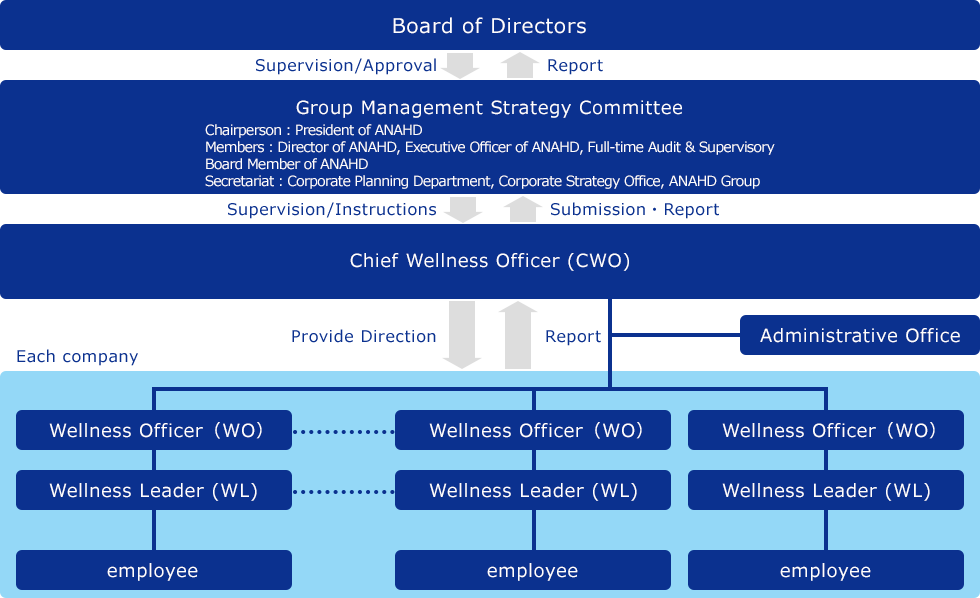

In addition to promoting public health awareness measures for employees, ANA actively communicates our health initiatives through internal communications, lectures and on our website..
Major Initiatives
Important Themes
We will implement the PDCA cycle for health and safety by focusing on the following:
- Health Management Initiatives
- Disease Prevention Initiatives
- Mental Health Initiatives
- Safety and Health Initiatives

1. Health Management Initiatives
To promote health and safety across the group, we first identified the scope of medical examinations to be conducted in the Group and established an environment for effective health care. Specifically, we developed a list of tests to be included in annual medical checkups across the Group and standardized the evaluation criteria so that all employees can be evaluated equally.
To offer day-to-day health care for ANA Group employees, we established eight Group healthcare facilities primarily at airport operation companies in addition to the existing ANA Healthcare Center.
Group Healthcare Facilities / Healthcare Center
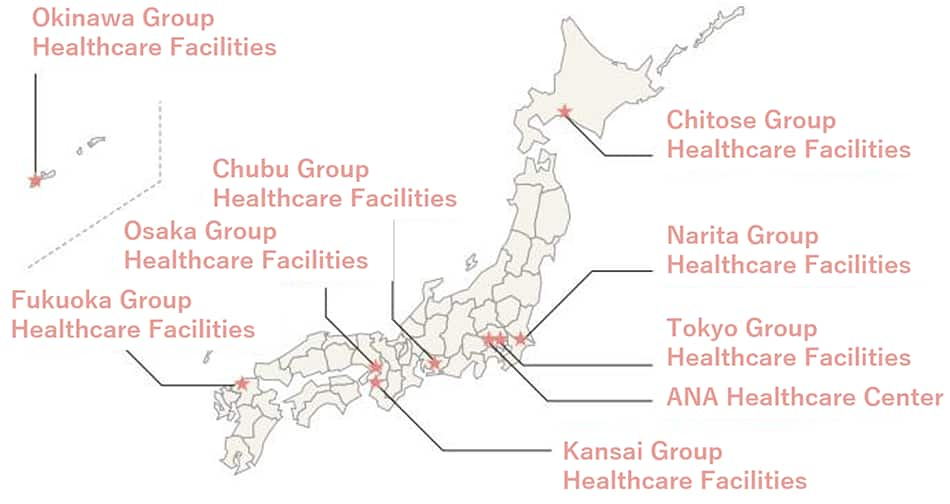
2. Disease Prevention Initiatives
In order to stay healthy and work for a long time, it is very important to take preventive measures to avoid getting sick. To this end, the ANA Group will implement the following initiatives.
Lifestyle Diseases Prevention
To prevent lifestyle diseases, the ANA Group has established health management indicators for employees and set a target for each indicator to be achieved by the entire Group and each Group company by the end of March 2030. Four health management indicators have been established: smoking rate, ratio of people with the risk of metabolic syndrome, body mass index (BMI), and ratio of people with complaints of physical pain. KPIs are set and monitored every year.
- The smoking cessation policy includes (online smoking cessation support program).
Cancer Prevention
As part of our efforts to prevent cancer, we are implementing e-learning programs for all group employees and adding colon cancer screening, which is the leading cause of death among Japanese people, to the list of health checkup items. We work together with the insurance association to promote cancer prevention and awareness.
Women's Health Measures
As a measure against diseases specific to women, we have added "mammary gland echography" (consultation rate in FY2024: 85.7%) as an examination item in health checkups for early detection of breast cancer, which is said to affect 1 in 11 women.
In fiscal 2016, during the Pink Ribbon Month (October every year), we distributed "breast palpation gloves" to female employees for use during self-checks.
In addition, since fiscal 2017, we have installed "breast palpation models" in various locations, where employees can experience the "lump" or "dimple" of breast cancer, to raise awareness of self-checking by actually touching them.
In addition, we will promote mutual understanding of health issues between men and women through e-learning and other means, and hold seminars by inviting industrial physicians and outside lecturers to promote initiatives targeting all Group employees, regardless of gender, age, or position.
3. Mental Health Initiatives
The ANA Group has appointed an ANA Group Mental Health Advisor (psychiatrist) to improve the environment for mental health-related initiatives, and is continuously working on “mental health promotion” while utilizing his/her expertise.
To improve self-control through the acquisition of correct knowledge and understanding of mental health issues among Group employees and to enhance line care for managers and supervisors, we distribute video materials that all Group employees can study anytime on demand, and hold case study seminars for managers (about 3 times a year online).
In response to the December 2015 requirement that businesses be required to conduct stress checks*, the ANA Group has worked together to establish a system for stress checks to prevent Group employees from developing mental health problems (primary prevention), and to provide individual follow-up for high-stress employees by the Group's occupational health staff. In addition to individual follow-up by the Group's occupational health staff, the ANA Group has also established external consultation services and held seminars for high-stress employees.
- The annual investment in external consultation services is 5.1 million yen. (Status of individual ANA companies)
We will continue to proactively develop initiatives to improve the mental health of employees through activities such as enhancing communications in the workplace.
- ANA Group conducts stress checks for all employees every year.
- In FY2024, the percentage of employees who took stress checks: 67.7%, the percentage of highly stressed: 10.9% (Status of individual ANA companies)

4. Safety and Health Initiatives
Implementation of Occupational Safety and Health Activities
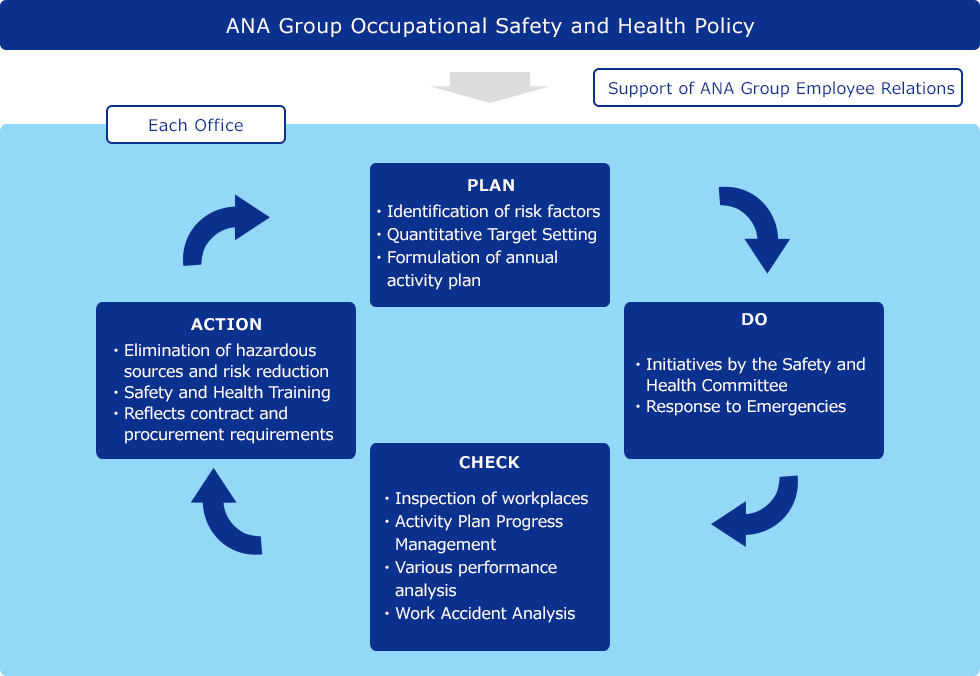

- Activities are reported to the Group Management Strategy Committee and the Board of Directors through the Chief Wellness Officer (CWO) as appropriate.
PLAN
- Risk factors are identified based on surveys and results related to safety and health, including work environment measurements, risk assessments, achievement status of health management indicators, results of periodic health checkups, stress check results, results of work-related accidents, and actual working hours.
The Safety and Health Committee deliberates on priorities, sets quantitative targets, and formulates an annual activity plan.
DO
- Based on an annual activity plan, the Safety and Health Committee at each workplace works together with industrial physicians, safety and health managers, and members recommended by the labor union to make effective efforts toward achieving targets.
- In the event of an emergency, a system is in place to ensure that primary measures, emergency transport, emergency communication, etc. can be appropriately implemented in accordance with the Emergency Action Manual prepared at each business unit based on the "ANA Group Total Risk Management Regulations".
CHECK
- At the Safety and Health Committee meeting held once a month, industrial physicians participate in workplace inspections to check workplace safety conditions, manage the progress of activity plans, and analyze the results of various health management activities such as occupational accidents, near-misses, and periodic health checkups, etc. for future health and safety activities.
- In the event of an occupational accident, we promptly analyze the causes of the accident based on interviews with the parties involved, on-site reconstructions, and photographs, and formulate future countermeasures, which are reported to and discussed by the Health and Safety Committee and disseminated throughout the workplace to prevent recurrence.
- The ANA Group Employee Relations Department inspects each ANA Group company to ensure that appropriate measures are being taken in light of the Labor Standards Law, the Industrial Safety and Health Law, etc., in accordance with a checklist based on the requirements of ISO 45001. Through these inspections, each company strives for early detection of problems and voluntary improvements, and works as one to prevent occupational accidents.
ACTION
- Based on the above analysis, the Safety and Health Committee deliberates on improvement measures to eliminate hazardous sources and reduce risks, and reflects the results in future activity plans.
- Safety and health training conducted at the time of hiring and when work content is changed reflects information such as risk factor analysis of workplaces, thereby raising awareness of the parties involved and preventing health injuries and occupational accidents.
- In contracts and procurement, the ANA Group Procurement Policy stipulates safety and health requirements for all suppliers of ANA Group services and products, including "ensuring a safe and hygienic work environment," "responding to industrial accidents and incidents," and "emergency response,". In addition, we confirm that all suppliers involved in ANA Group services and products meet the occupational safety and health standards required by the ANA Group prior to signing a contract.
Occupational Accidents
| 2019 | 2020 | 2021 | 2022 | 2023 | 2024 | |
|---|---|---|---|---|---|---|
| Number of occupational accidents Work-related accidents |
69 | 25 | 26 | 65 | 87 | 97 |
| Number of occupational accidents Commuting accidents |
24 | 9 | 16 | 19 | 22 | 21 |
| Rate of occupational accidents | 3.59 | 1.03 | 1.29 | 3.47 | 4.38 | 4.90 |
Other Themes
ANA Group Exercise program
The ANA Group Exercise program was developed to enhance safety and health. By doing these daily exercises, employees can feel refreshed and improve their health, and additionally attain a heightened awareness of occupational accident prevention.
In November 2019, we also introduced a health promotion application, MY HEALTH WEB, for all Group employees. In addition to consolidating the dissemination of health-related information in this app, we are encouraging the development of healthy exercise habits by holding web-based walking competitions using the app.
We will continue to develop safety and health activities across the Group in order to create a healthy and vigorous work environment.
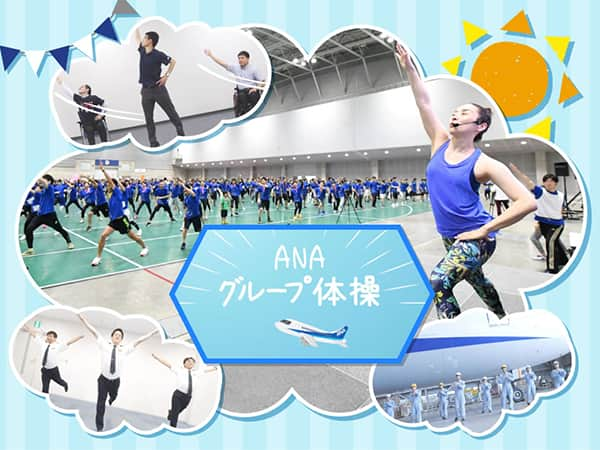
ANA Group Exercises Opens in a new window.In the case of an external site,it may or may not meet accessibility guidelines.
Initiatives Related to Health
The ANA Group will continue to promote employee health throughout the year at each Group company with themes such as diet, smoking cessation, and exercise. We will continue to actively hold seminars and events related to employee health.
- Web walking contest (Respondents who answered "would like to participate again" in the survey ... about 97.5%).
- Mental seminar (online)
- Mental Health Course (E-learning)
- Special meals named after "Yasai (831)" day are offered at some cafeterias.
Health seminars connected in a relay format by health care offices across the country. - Respondents who responded to the survey that they would like to take action...about 90.3%.
etc…
We will continue to promote initiatives to maintain and improve health.

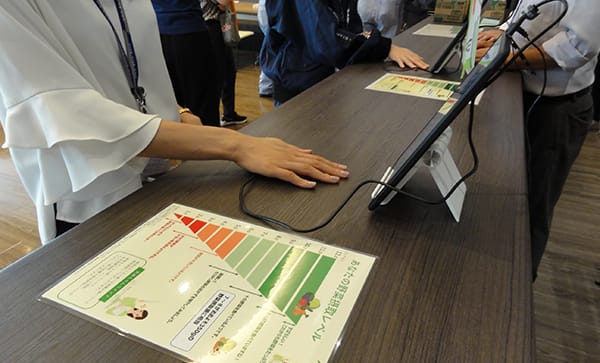
Analysis of Health-Related Information
The ANA Group is examining the results of health checkups and other information (through data processing) to better understand the health issues and characteristics of employees so that we can respond effectively to these issues.
In compliance with the relevant laws and regulations regarding personal information, we are analyzing health checkup results, and the mental impact of the Coronavirus pandemic and are studying how to use this data to maintain and improve the health of our employees.
- At ANA, 99.5% of employees covered by law receive regular health checkups.
Employee Occupational Safety and Health Education
ANA Group holds a number of seminars For Group employees to prevent occupational accidents and promote employee health. We made it easy for employees to attend seminars because we believe that it is important for every employee to raise awareness of safety and health and to maintain a state of constant awareness.
| Theme | Details of implementation | Number of times implemented | Number of participants |
|---|---|---|---|
| 1. Seminars on Mental Health | To maintain and promote mental health, etc. |
8
|
3,371
|
| 2. Health Office/Center Relay Seminar | To connect health care offices across the country in a relay format to obtain a wide range of health information. |
9
|
1,246
|
| 3. Training seminars for new employees | To promote basic matters and understanding of occupational health and safety and health management for new employees |
13
|
680
|
| 4. Sleep Seminars | Learn about quality sleep, including the importance of sleep and the benefits it brings. |
1
|
308
|
| 5. Women's health seminar - diseases specific to women, etc. | To deepen understanding of the theme of "women's health" not only among female employees but also among male employees |
1
|
130
|
Production of English Versions of ANA Group Exercises
The ANA Group has focused on the globalization of activities to promote and expand health management with reference to the health management initiatives of other companies, and has produced an English version of the "ANA Group Gymnastics" video.
The Japanese version of "ANA Group Gymnastics" was produced under the supervision of Renaissance Corporation to help each and every employee stay healthy in mind and body and work with a smile on their face. The production of the exercise program was inspired by the request of ANA Group employees working overseas, who said, "We want to do the ANA Group Exercise with them.
In addition to preventing occupational accidents and increasing communication, the exercise programs have helped foster a sense of unity within the ANA Group.
- ANA Group Gymnastics sessions are also available on YouTube, opening them up to a wider audience.
Results of Initiatives
In order to promote the ANA Group's Health policies, we set up issue-based indicators, and are circulating the PDCA cycle to improve the indicators. To assess the impact of our management initiatives, we are analyzing data on absenteeism*2 and presenteeism*3 as health-related costs.
- *2.Absenteeism: Individuals who are absent from work, take leave, arrive late, or leave early due to physical or mental health problems.
- *3.Presenteeism: A condition in which an employee's performance declines due to physical or mental health problems, even though he or she attends work.
- Employee Health Issues
- Changes in Employee Health Status
- Loss/Impact of Health Conditions
1. Employee Health Issues
Presence of Lifestyle-Related Diseases
- The rate of lifestyle-related diseases is increasing rapidly among men in their 40s and among women in their 50s.
- Since lifestyle-related diseases can lead to complications if they worsen, we are trying to raise awareness of the need to change lifestyle habits as early as possible, rather than waiting until they worsen.
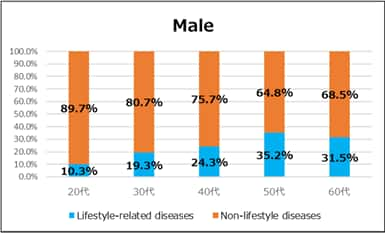
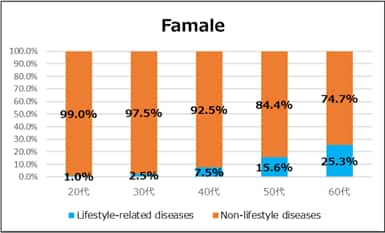
(*ANA individual company figures_2024)
Distribution of BMI
- 70% of both men and women were of normal weight.
- While 20% to 30% of men were obese and this number tended to increase with age, 20% to 30% of women were underweight. Low body weight is not only bad for back pain, but can also cause anemia (tiredness and lethargy) as well as risks during pregnancy and childbirth, thus confirming the importance of working to achieve proper body weight.
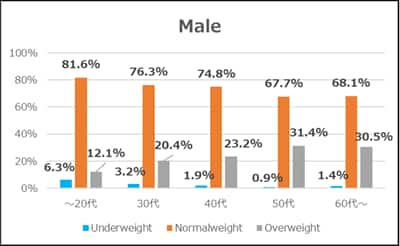

(*ANA individual company figures_2024)
About Smoking
- Smoking rates are below the national average for both men and women and are steadily declining.
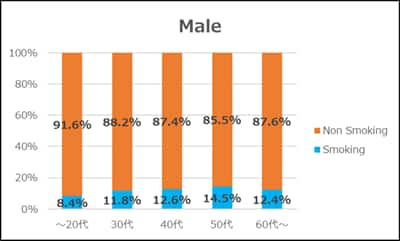

(*ANA individual company figures_2024)
Based on the above, we aim to set indicators related to "BMI," "smoking rate," and "metabolic syndrome," as well as to improve mental health-related conditions.
An indicator based on the number of "physical complaints" was established from the stress check, and these four points were defined as health management indicators.
Click here for health management index environmental and social data
- The "≦" indicates a smaller or equal value.
- The "<" indicates less than or equal to.
- The "=" indicates equality.
- The "÷" indicates division.
- Presence or absence of lifestyle-related diseases
- Lipodystrophy LDL-C 160+TG 400+
- Hypercapnia BP 160/100 or more
- Diabetes mellitus HbA1c 6.5 or more
- BMI ratio: Percentage of people with a BMI of 18.5 ≤ BMI < 25 (BMI = weight in kg ÷ (height in m)2)
- Smoking rate: Percentage of smokers
2. Changes in the Health Status of Employees
Across the entire ANA Group, the rate of physical complaints has decreased. Other indicators have remained unchanged.
In ANA, the smoking rate and physical complaint rate are steadily decreasing.
| Index | Target Value (March 2030) |
2018 | 2019 | 2020 | 2021 | 2022 | 2023 | 2024 |
|---|---|---|---|---|---|---|---|---|
| BMI Appropriate Ratio | 70.0 or more | 67.7 | 67.6 | 64.8 | 67.5 | 67.4 | 67.1 | 66.0 |
| Smoking Rate | Less than 20.0 | 28.8 | 27.3 | 24.9 | 23.6 | 23.2 | 23.1 | 22.5 |
| Rate of Metabolic Syndrome | Less than 12.0 | 15.8 | 15.2 | 17.5 | 13.6 | 13.6 | 13.2 | 13.1 |
| Body Complaint Rate | Less than 20.0 | 24.1 | 26.2 | 26.6 | 22.2 | 25.6 | 25.7 | 26.1 |
| Index | Target Value (March 2030) |
2018 | 2019 | 2020 | 2021 | 2022 | 2023 | 2024 |
|---|---|---|---|---|---|---|---|---|
| BMI Appropriate Ratio | 70.0 or more | 72.7 | 73.4 | 70.8 | 69.9 | 68.5 | 69.1 | 70.3 |
| Smoking Rate | Less than 3.0 | 6.5 | 5.2 | 3.6 | 3.5 | 3.6 | 3.4 | 3.6 |
| Rate of Metabolic Syndrome | Less than 1.3 | 2.0 | 1.5 | 2.4 | 1.8 | 1.6 | 1.4 | 1.6 |
| Body Complaint Rate | Less than 30.0 | 33.5 | 41.3 | 33.4 | 30.6 | 38.5 | 39.9 | 39.9 |
| Index | Target Value (March 2030) |
2018 | 2019 | 2020 | 2021 | 2022 | 2023 | 2024 |
|---|---|---|---|---|---|---|---|---|
| BMI Appropriate Ratio | 75.8 or more | 72.9 | 72.5 | 67.8 | 74.3 | 73.7 | 73.4 | 72.7 |
| Smoking Rate | Less than 11.7 | 17.2 | 16.7 | 14.5 | 14.1 | 13.6 | 13.7 | 12.6 |
| Rate of Metabolic Syndrome | Less than 9.8 | 18.2*4 | 12.9 | 12.6 | 11.2 | 11.1 | 9.5 | 11.0 |
| Body Complaint Rate | Less than 15.9 | 21.4 | 20.6 | 29.1 | 15.7 | 20.3 | 19.0 | 20.5 |
| Index | Target Value (March 2030) |
2018 | 2019 | 2020 | 2021 | 2022 | 2023 | 2024 |
|---|---|---|---|---|---|---|---|---|
| BMI Appropriate Ratio | 69.9 or more | 72.6 | 73.0 | 70.1 | 69.1 | 68.4 | 70.8 | 71.7 |
| Smoking Rate | Less than 2.0 | 3.7 | 3.1 | 2.6 | 2.3 | 2.4 | 2.2 | 2.1 |
| Rate of Metabolic Syndrome | Less than 0.8 | 1.6*4 | 1.0 | 1.5 | 1.3 | 1.0 | 0.9 | 1.2 |
| Body Complaint Rate | Less than 23.5 | 41.9 | 37.6 | 30.4 | 22.3 | 30.3 | 35.3 | 38.4 |
- *4.Some definitions of indicators have been changed since FY2018. (Old standard for FY2018 results: male 11.1 female 1.4)
- .u-mb-0
- BMI ratio: Percentage of people with a BMI of 18.5 ≤ BMI < 25 (BMI = weight in kg ÷ (height in m)2)
- Smoking rate: Percentage of smokers
- Metabolic syndrome rate: Percentage of people aged 40 and over who meet the criteria for metabolic syndrome diagnosis
- Applicable rate of body complaints: Percentage of those with 3 or more somatic complaints
- Somatic complaints: a symptom of a disorder that is manifested in the body
ex) Back pain, tired eyes, stomach problems, etc. - Percentage of employees receiving a full medical examination after regular health checkups: 100%
- Continuation rate of health guidance, etc. for those requiring management: 100%
(All of the above are the performance status of individual ANA companies.)
3. Loss and Impact of Health Conditions
Most of the health-related costs are losses due to presenteeism (reduced employee productivity).
Health-related costs per capita are shown in the graph below.
- FY2024
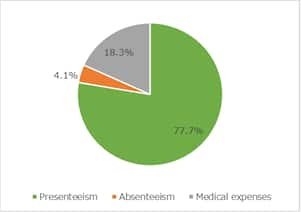

Calculations were based on the number of survey respondents who responded to both the absenteeism and presenteeism questions (7,559 respondents).
Medical costs are calculated from receipt data.
Presenteeism = [Presenteeism loss ratio] x [Annual per capita income (salary & bonus) in FY2024].
Absenteeism = [Absenteeism (days)] x [Daily income per capita (annual income divided by 365 days) in FY2024].
- FY2023


Calculations were based on the number of survey respondents who responded to both the absenteeism and presenteeism questions (8,719 respondents).
Medical costs are calculated from receipt data.
- Calculation method is as above
External Evaluation
As stated in the ANA Group Health Management Declaration, we believe that ensuring the safety and health of our employees and creating a comfortable work environment are the foundation of our corporate activities. In addition, we are also working to reform the way we work by promoting remote work and will continue to accelerate these efforts.
| Awards and Recognition | Logo | Implementing body |
|---|---|---|
| Health and productivity |  |
Ministry of Economy, Trade and Industry, Japan Exchange Group |
| Health and productivity White 500 |  |
Nippon Kenko Kaigi |
| SAFE Consortium Award Silver Award, Business-to-Business Collaboration Category |
 |
Ministry of Health, Labour and Welfare |
| Awards and Recognition | Logo | Implementing body |
|---|---|---|
| Health and productivity |  |
Ministry of Economy, Trade and Industry, Japan Exchange Group |
| Health and productivity White 500 |  |
Nippon Kenko Kaigi |
| SPORTS YELL COMPANY |  |
Japan Sports Agency |
| Awards and Recognition | Logo | Implementing body |
|---|---|---|
| Health and productivity |  |
Ministry of Economy, Trade and Industry, Japan Exchange Group |
| Health and productivity White 500 |  |
Nippon Kenko Kaigi |
| Awards and Recognition | Logo | Implementing body |
|---|---|---|
| Health and productivity White 500 |  |
Nippon Kenko Kaigi |
| Awards and Recognition | Logo | Implementing body |
|---|---|---|
| Health and productivity White 500 |  |
Nippon Kenko Kaigi |
| SPORTS YELL COMPANY |  |
Japan Sports Agency |
| tokyo sports promotion company certification program |  |
Tokyo Metropolitan Government |
| Awards and Recognition | Logo | Implementing body |
|---|---|---|
| Health and productivity White 500 |  |
Nippon Kenko Kaigi |
| SMART LIFE PROJECT |  |
Ministry Health Labour and Welfare Japan Sports Agency |
| SPORTS YELL COMPANY |  |
Japan Sports Agency |
| tokyo sports promotion company certification program |  |
Tokyo Metropolitan Government |
| beyond2020 my best program |  |
Cabinet Secretariat |
| Awards and Recognition | Logo | Implementing body |
|---|---|---|
| Health and productivity White 500 |  |
Nippon Kenko Kaigi |
| SPORTS YELL COMPANY |  |
Japan Sports Agency |
| tokyo sports promotion company certification program |  |
Tokyo Metropolitan Government |
| Rubella zero project |  |
Japan Association of Obstetricians and Gynecologists |
| Awards and Recognition | Logo | Implementing body |
|---|---|---|
| Health and productivity |  |
Ministry of Economy, Trade and Industry, Japan Exchange Group |
| Health and productivity White 500 |  |
Nippon Kenko Kaigi |
| Awards and Recognition | Logo | Implementing body |
|---|---|---|
| Health and productivity White 500 |  |
Nippon Kenko Kaigi |